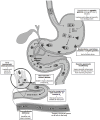Unraveling the Enigma: Food Cobalamin Malabsorption and the Persistent Shadow of Cobalamin Deficiency
- PMID: 40283381
- PMCID: PMC12027676
- DOI: 10.3390/jcm14082550
Unraveling the Enigma: Food Cobalamin Malabsorption and the Persistent Shadow of Cobalamin Deficiency
Abstract
Food cobalamin malabsorption (FCM) represents a prevalent, often underdiagnosed, etiology of vitamin B12 deficiency, particularly within an aging population. Unlike pernicious anemia, an autoimmune disorder targeting intrinsic factor, FCM stems from the impaired release of cobalamin from food proteins, primarily due to age-related gastric changes, medication-induced gastric hypochlorhydria, metformin, or non-immune atrophic gastritis. The clinical presentation of FCM mirrors that of general cobalamin deficiency, encompassing a spectrum of neurological (peripheral neuropathy, cognitive decline), hematological (megaloblastic anemia), and gastrointestinal (glossitis, anorexia) manifestations. Given the potential for irreversible neurological sequelae, early detection and intervention are paramount. High-dose oral cobalamin (125-250 mcg daily) has demonstrated efficacy, offering a convenient and cost-effective alternative to parenteral administration.
Keywords: cobalamin deficiency; cobalamin treatment; food cobalamin malabsorption; pernicious anemia; vitamin B12 deficiency.
Conflict of interest statement
The authors declared no conflicts of interest.
Figures
References
-
- Guéant J.L., Guéant-Rodriguez R.M., Alpers D.H. Chapter Nine—Vitamin B12 absorption and malabsorption. In: Litwack G., editor. Vitamins and Hormones. Volume 119. Academic Press; Cambridge, MA, USA: 2022. [(accessed on 27 March 2025)]. pp. 241–274. Available online: https://www.sciencedirect.com/science/article/pii/S0083672922000164. - PubMed
-
- NICE CKS Anaemia—B12 and Folate Deficiency. 2023. [(accessed on 29 December 2023)]. Available online: https://cks.nice.org.uk/topics/anaemia-b12-folate-deficiency.
-
- Carmel R., Sinow R.M., Siegel M.E., Samloff I.M. Food cobalamin malabsorption occurs frequently in patients with unexplained low serum cobalamin levels. Arch. Intern. Med. 1988;148:1715–1719. - PubMed
-
- Pardo-Cabello A.J., Manzano-Gamero V., Puche-Cañas E. Vitamin B12: For more than just the treatment of megaloblastic anemia? Rev. Clin. Esp. 2023;223:114–119. - PubMed
Publication types
LinkOut - more resources
Full Text Sources
Miscellaneous


